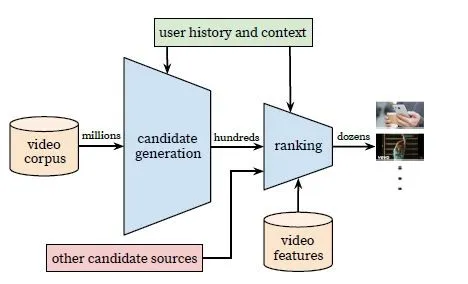Looking for an iRECORENCE model with ML/AI
When you shop on Amazon or Flipkart, you cannot miss the ‘recommendations’ listed as part of the product description you are looking at, or at the final buy confirmation. Recommender Systems have been used for many years now to address the problem of information overload.

How? By providing a customised and personalised target recommendation for a customer by the online retailer. This helps the shopper see what "their type" are shopping, and what they like to buy. This avoids the growing amount of useless information, which, in turn, increases the navigation complexity.
This also ensures I do not need to go through a huge list of feedback and reviews from existing customers. Leading recommender systems learn about the usage patterns of users, and customise the content, appearance, and behavior – thanks to the machine learning algorithm!
In the bargain, I have lost an important battle - "my privacy". All for what? For better service. The ML/AI algorithms are crunching data from my browsing history, online shopping behavior, purchase history, cart history, etc. Data scientists are making algorithms hungrier for data so that they can be more adaptive by understanding my interests, background and even traits. Information given by me directly, and through observation of my patterns, constantly updates the algorithm.
Major online platforms such as Facebook, Google, and Twitter allow third-party applications such as games and productivity applications access to user online private data.
Such accesses are authorised by users at the time of installation, thanks to the “The Open Authorization protocol (OAuth)”, which was introduced as a secure and efficient method to authorise third-party applications without releasing a user's access credentials.
Though it doesn't provide the necessary fine-grained access control, nor recommendations on which access control decisions are most appropriate, there are efforts to provision fine-grained authorisation recommendations to users when granting permissions to third-party applications. When they are implemented, hopefully, users are aware and are a part of inputs to the “learning algorithms” to make it more human!
An example of “YouTube” recommendation engine below takes care of the complex challenges of building such a system around Scale (Handling massive user base and corpus), Freshness (managing dynamic corpus and developing a system which is responsive enough to model newly uploaded content as well as the latest actions taken by the user) and Noise (Predicting due to sparsity and a variety of unobservable external factors).

Illustration Source: https://static.googleusercontent.com/media/research.google.com/ru//pubs/archive/45530.pdf
Eventually, we will have a self-learning adaptive system that will put a recommendation list which will mirror what I want to buy, making way to more impulse purchases. When I see this recommendation list, I feel happy - it's as if I have someone who understands my needs! So if this is the case, what is missing?
A recommendation list integrated with reviews from customers is the start point of my shopping journey. We usually buy using peer advice (friends and family) as we trust their choice. This helps me understand the experience of the product or service post a few months, or even a few years, of purchase. Basically then, I am looking at a robust Reference model integrated with the recommendation model. I think this will be on the rise as the millennial generation rely more on peer recommendation than what they read or see.
A personal reference is a reference provided by an individual who knows you, and can vouch for the products he has bought or experienced and mainly whom you trust. Trust is the main component here. Depending on the type of product or service you are buying, personal references can be an excellent choice to support your shopping decision.
References are common when we are looking for services in the areas of Healthcare, finance and legal. When you are looking for the best hospital, or when you want a reference to identify the best doctor for your surgery, we always rely on personal and professional references.
For example, when I want to visit a certain doctor at a leading hospital in Bengaluru, I look up Practo to see the review and stars the doctor has got before making an appointment. I call up my friend who has recently undergone a similar medical treatment for a personal reference.
Also, when looking at a particular investment in real-estate or in mutual funds, we always have a list of friends we talk to, whose comments and references make a huge influence in our choice of investment. Similarly, when we have to pick a legal counsel, we always call the most trusted friend for advice.
We have seen successful use of reference models while shopping for products too, like automotive, fitness and electronics. When you have to buy a new car, or when you have to buy a treadmill, or even a phone, you have a list of friends you call up who you consider as experts for a reference.
The ideal engine should be able to help me capture this reference, with the recommendation model where machine learning algorithms have done their magic. If we overlay the reference model on the recommendation model, we get a complete picture of the product or service, as it not only has a snapshot of the product or service at a particular time, but will also give feedback with respect to time from the existing users. Of course, the referrers need to be incentivised for their inputs and comments. There are very advanced static and dynamic incentive models which also can be integrated into the system. The decision user takes now is well-informed, and which shopper won't like that feeling?
This completes my temptation cycle to shop more, and have a so-called fulfilling shopping experience which creates greater customer stickiness and loyalty. Integration of open model (Recommendation) and closed model (Reference Model) would create a better model for an informed decision.
Experts in this field, the question for you - Can I expect a combined model of RECOMMENDATION, INCENTIVES and REFERENCE Models, or can I expect an iRECORENCE model?
Disclaimer: I am not a data scientist, or have expertise in Machine learning (ML) or Artificial Intelligence (AI). I am simply an addicted e-shopper!
(Disclaimer: The views and opinions expressed in this article are those of the author and do not necessarily reflect the views of YourStory.)







